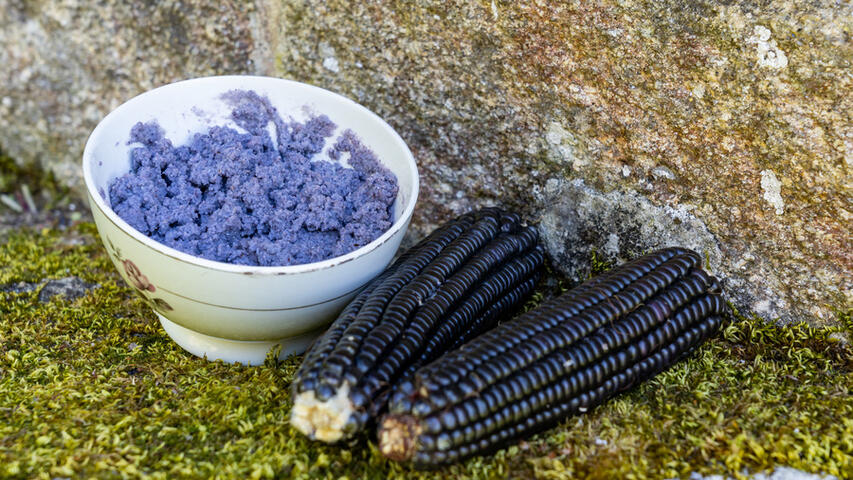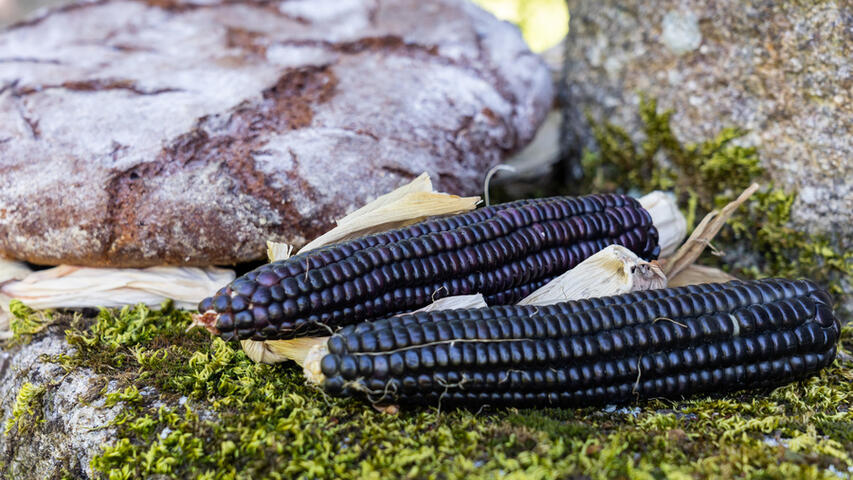Millo Corvo in Bueu
Tasty dishes with black cobs
Bueu recovers this unique variety of corn that was almost extinct two decades ago.
The black colour is its hallmark. Hence its name: millo corvo. A name, in turn, linked to two others: that of Bueu, where its festival takes place; and that of the Meiro Cultural Association, in charge of highlighting the benefits of this delicacy in a celebration that has already been recognised as a tourist attraction. This maize, which is different because of its dark-coloured kernel, adds to the tasting the presentation of other artisan and ecological products.

Millo Corvo in Bueu
These peculiar cobs come from those originally sown in these lands of O Morrazo. The first evidence of corn cultivation dates back to the 17th century. Over time, the harvesting of the millo corvo went from being done in wooded areas and in those areas where a variety was needed to act as a protector of the others to practically disappearing, replaced by other species.
Recovery of the species
Thus, in O Morrazo, a process of recovery of this species had to be carried out. This took place in 1998. Almost extinct, the most appropriate grains and cultivation techniques were sought until the dark tones were once again appearing in the maize fields. The villages of O Morrazo were visited and the neighbours, especially the older ones, were questioned. Today, this festival, which has been of tourist interest in Galicia since 2009, offers visitors all kinds of historical, ethnographic and gastronomic activities with the arrival of spring.
Thus, it is possible to visit the mills to observe the corn milling process, enjoy performances by local musical groups, taste the queimada while listening to its "esconxuro" or try very different elaborations with this product as a base. Bread baked with maize flour, which is also distinguished by its dark colour, stands out in particular. Other delicacies that make their way to the tables of Meiro include pies and tarts . And, once again, the millo corvo proves that it goes well with biscuits, walnuts, almonds or fruit.
Among the main points of this event are also the mills of O Canudo and A Presa, where corn is milled every year. The latter, which dates back to 1800 and was restored in 1996, was precisely the one that gave the event its impetus. It has a ground floor and the water is collected directly from the river by means of a stone channel that allows the corn to be milled.
Traditional techniques
The process of obtaining the millo corvo today follows the instructions learnt for centuries: in Bueu, the whole procedure is tried to be as natural and artisanal as possible, as it was for past generations. Thus, the sowing, harvesting, picking and preserving of the grain are all marked by traditional methods and techniques, which gives a unique flavour to the dishes that hundreds of visitors come to the village of Meiro to taste every year.

Festa do Millo Corvo
Bueu celebrates everything from planting and cultivation to the preparation of different dishes with corvo millet, a species that once served as a natural barrier between the forest and the white corn itself, keeping predators away, and which today is the main protagonist. With its recovery, Meiro returns to the past every time one of the harvest activities takes place, at the same time favouring the respect and enhancement of the environment. Thus, in addition to the corvo corn, other traditional varieties such as white or red corn are on display at this meeting.
Slow Food
It was in 2006 that the Slow Food organisation, a defender of the principles of traditional and environmentally friendly food, included corvo millet in its prestigious "Ark of Taste" catalogue. At that time it was one of the few Spanish products included in this list thanks to the work of those who promoted its recovery.

